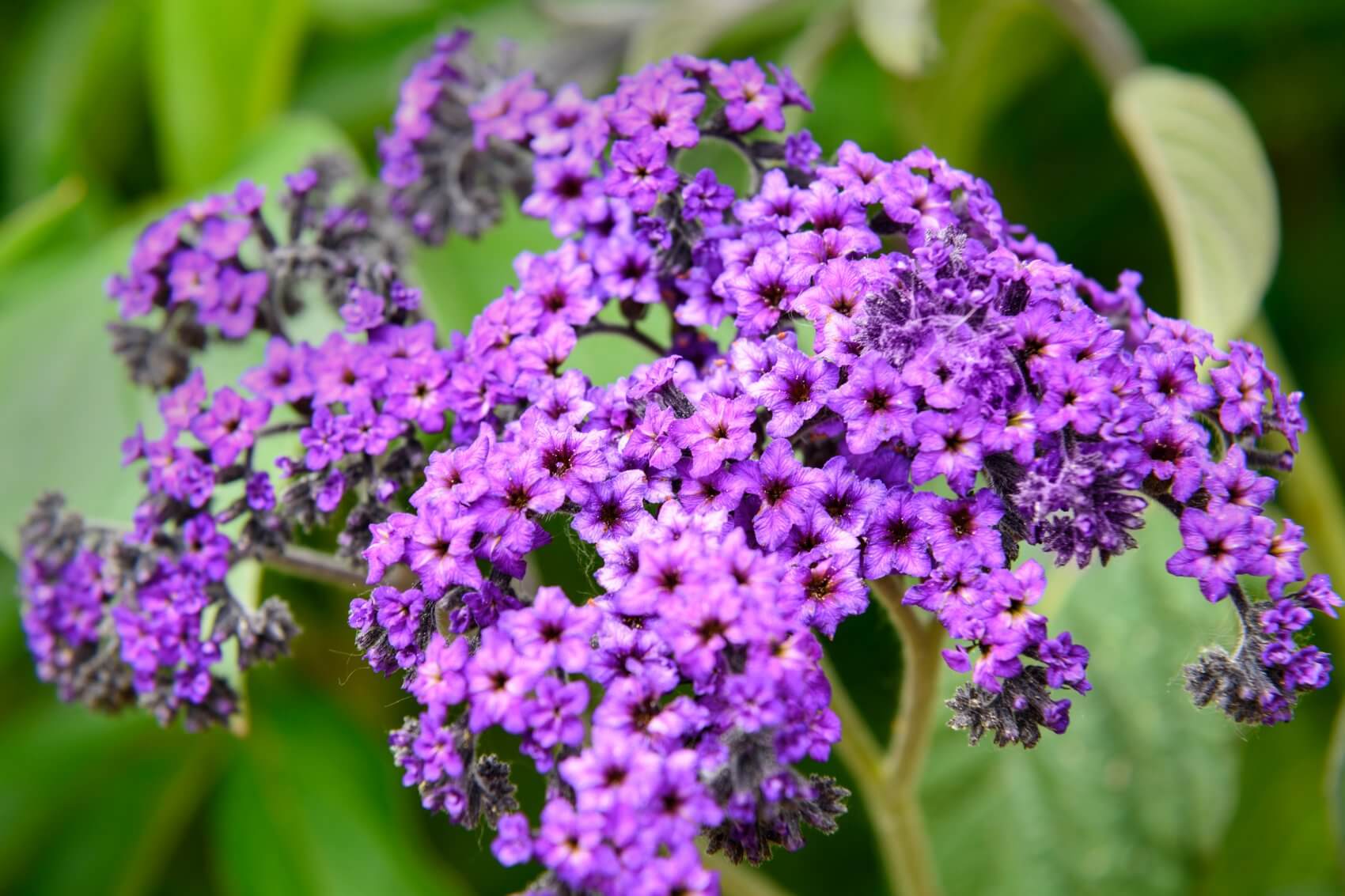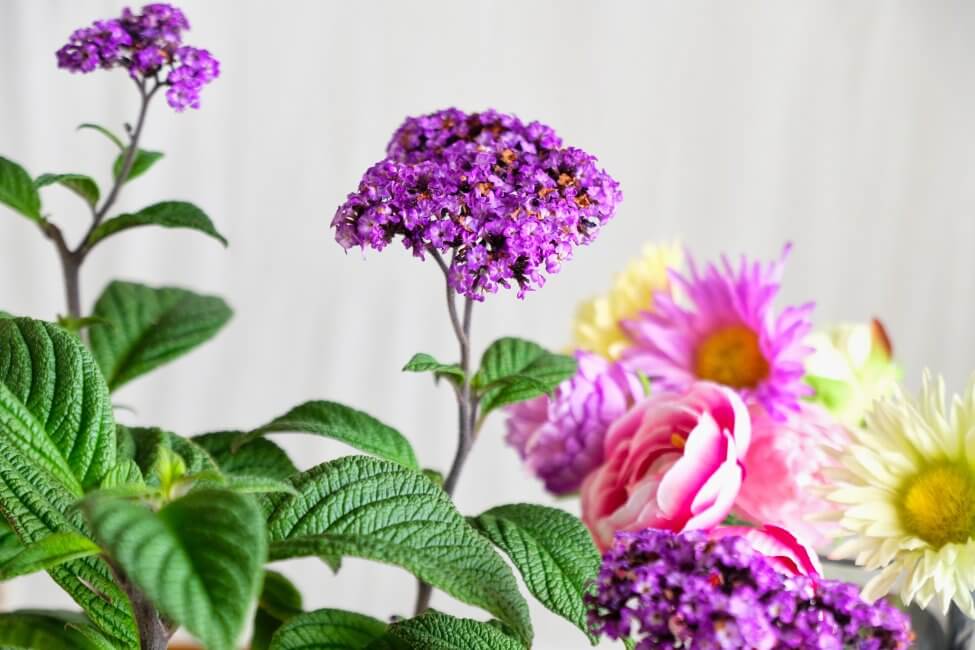The cherry pie plant, commonly known as heliotrope, has been a beloved flower in cottage gardens for many years, dating back to the Victorian era. This perennial boasts beautiful clusters of purple, blue, and white blooms that attract important pollinators to your garden. Not only is this flower visually stunning, but it also has a delightful scent reminiscent of vanilla and freshly baked pie, which makes it highly sought after. Additionally, in the language of flowers, heliotrope represents steadfast devotion and eternal love. In this article, we’ll explore the history and significance of heliotrope flowers, as well as their various uses and benefits, popular varieties, and cultural importance across the globe today.

The Heliotrope flower is an elegant and fragrant bloom that has captured the hearts of many. Belonging to the borage family, the Heliotrope flower has various species and cultivars with distinct colors and fragrances. These beautiful flowers are known for their ability to follow the sun’s path throughout the day, which makes them a symbol of devotion.
Heliotrope Flowers – Family, Genus, and Taxonomy
The Heliotrope flower belongs to the Boraginaceae family, which also includes other popular plants like forget-me-nots and borage. The genus name for the Heliotrope flower is Heliotropium, with over 250 different species found across the world.
Botanical Characteristics, Colors, Fragrances, and Toxicity
Heliotrope flowers are known for their unique fragrance that is reminiscent of vanilla or almond. They come in various colors, ranging from shades of white, purple, blue, and pink. However, it’s important to note that all parts of the Heliotrope plant are toxic if ingested, so it’s best to keep them out of reach from children and pets.
Popular Heliotrope Flower Types, Species, and Cultivars
Some of the most popular types of Heliotrope flowers include the Marine Heliotrope, Cherry Pie Heliotrope, and White Queen Heliotrope. Each of these varieties has its distinct colors and fragrances.
Etymological Meaning
The name Heliotrope is derived from the Greek words “helios” meaning sun and “tropos” meaning turning. This name refers to the flower’s ability to track the sun’s movements throughout the day.
What Regions are Heliotrope Flowers Native To?
Heliotrope flowers are native to regions such as South America, Africa, and Asia. However, they can now be found in various parts of the world, including Europe and North America.
When are Heliotrope Flowers in Season?
Heliotrope flowers typically bloom in the summer months, from June to August. However, this may vary depending on the specific species and location.
Uses and Benefits of Heliotrope Flowers
Heliotrope flowers have been used for various purposes throughout history. They have been used in herbal medicine to treat respiratory problems and skin irritations. Additionally, their fragrance has made them a popular choice for perfumes and other scented products.
Heliotrope Flowers in Herbalism and Medicine
Heliotrope flowers have been used in traditional medicine to treat respiratory issues, such as bronchitis and asthma. They were also used to soothe skin irritations like eczema and psoriasis.
Toxicity, Bee Friendliness, and Pollination
All parts of the Heliotrope plant are toxic if ingested, so it’s important to handle them with care. However, bees are attracted to their sweet fragrance and can help with pollination.
Heliotrope Flower Meaning Symbolism
Heliotrope flowers have a rich symbolism that dates back to Greek mythology. They are said to symbolize devotion, faithfulness, and loyalty. In some cultures, they are also associated with good luck and prosperity.
Common Heliotrope Flower Colors
Heliotrope flowers come in various colors, but the most common ones include shades of purple, blue, and pink.
The Meaning, Symbolism, and Cultural Significance of Heliotrope Flowers
Heliotrope flowers have been used as symbols of devotion and loyalty for centuries. They are often given as gifts to express love and appreciation. In Victorian times, they were also associated with good fortune and wealth.
Suitable Gifting Occasions for Heliotrope Flowers
Heliotrope flowers make excellent gifts for occasions such as birthdays, anniversaries, and Valentine’s Day. They are also a suitable choice for expressing sympathy or gratitude.
How to Care for Fresh-Cut Heliotrope Flowers
To keep your fresh-cut Heliotrope flowers looking their best, it’s important to change the water frequently and trim the stems every few days. They also prefer cooler temperatures and a shady location.
Wrap-up
In conclusion, the Heliotrope flower is a beautiful and fragrant bloom with a rich history and symbolism. Whether you’re gifting them to a loved one or enjoying them in your garden, they are sure to bring joy and beauty into your life.
Heliotrope Flowers FAQ
Q: Are Heliotrope flowers poisonous?
A: Yes, all parts of the Heliotrope plant are toxic if ingested.
Q: What colors do Heliotrope flowers come in?
A: Heliotrope flowers come in various shades of white, purple, blue, and pink.
Q: When do Heliotrope flowers bloom?
A: Heliotrope flowers typically bloom in the summer months, from June to August.
Q: What do Heliotrope flowers symbolize?
A: Heliotrope flowers are said to symbolize devotion, faithfulness, and loyalty.

The heliotrope flower belongs to the borage family, scientifically known as Boraginaceae, and is represented by the genus Heliotropium. This genus includes approximately 325 species, with the most common being the cherry pie plant or H. arborescens, which is found in the Americas and Europe. Heliotrope flowers grow as an annual in cooler climates and a perennial or half-hardy perennial in warmer regions, reaching up to six feet tall and eight feet wide in their natural habitat. The leaves have a dark green color with prominent veins, rough to the touch, and arranged alternately. The flowers of heliotrope bloom during the summer or fall, presenting themselves in clusters of purple, blue, white, or pink hues. Buds start as dark purple and lighten as they mature. Heliotrope flowers have a distinct fragrance, often compared to vanilla, sugar, or freshly baked cherry pie. It’s important to note that every part of this plant is toxic to humans, causing digestive problems or liver damage when ingested in large amounts. Long-term ingestion of this plant has been known to cause severe liver damage to horses. There are several popular species and cultivars of heliotrope flowers available for purchase.

The Heliotropium family boasts a diverse range of over 320 species, with the most commonly grown ornamental being H. arborescens. Some popular cultivars of this species include ‘Fragrant Blue,’ which emits a strong fragrance and turns deep blue in cooler temperatures, and ‘Marine,’ a compact variety that produces dark purple blossoms and grows up to 14 inches tall. Other species of heliotrope are also worth noting, such as the drought-tolerant H. amplexicaule, native to South America and now considered an agricultural weed in Australia due to naturalization; the European H. europaeum, an annual with white flowers and a strong, unpleasant scent; the Asian H. indicum, growing up to 19 inches tall with light purple and white flowers atop a striking green calyx; and the salt-tolerant ground cover H. curassavicum, which spreads up to four feet wide and blooms white flowers year-round. The name “heliotrope” stems from the Greek words for sun and turning, referencing the flowers’ tendency to follow the sun throughout the day. Another name for these flowers is “turnsole,” an old Middle English word meaning to turn towards the sun.

Heliotropium plants can be found all over the world, from the Americas to Asia, Africa, and Europe. Among these plants is the popular H. arborescens, which originally hails from subtropical regions in Peru. These lovely flowers are known to bloom during the summer, displaying clusters of small, fragrant blossoms in soft shades of pink, purple, or white that grow on gracefully curving stems.
While heliotropes can be grown as perennials in USDA Zones 10 and 11, in cooler zones, they are typically cultivated as annuals. Regardless of the method, they are a beautiful addition to any garden.
In addition to their ornamental value, heliotrope flowers have numerous benefits. Some people believe that the scent of the flowers can help soothe one’s mind and promote relaxation, while others use it to alleviate headaches or as an ingredient in perfumes. Overall, heliotrope is a versatile and fascinating plant that has captured the hearts of gardeners and flower enthusiasts worldwide.

The Doctrine of Signatures, a belief in 16th century Europe, suggested that plants resembling certain body parts could have medicinal effects on those parts. Heliotrope, which “followed the sun” and was believed to affect circulation and breathing, was commonly used for medicinal purposes. However, it is now known that heliotrope contains compounds that can harm the liver and should not be ingested. Instead, topical treatments such as tinctures or essential oils may be used for skin ailments. In traditional Filipino medicine, Indian heliotrope is used to treat ulcers, wounds, and conjunctivitis. It is important to note that all parts of H. arborescens are toxic to humans and animals. Despite this, heliotrope is attractive to bees, butterflies, and other pollinators and can be a valuable addition to a pollinator garden.

The heliotrope flower comes in various colors, including purple, blue, white, and pink. In the language of flowers, it is a symbol of eternal love and devotion. The flower’s symbolism has its roots in Greek mythology, where Clytie, a water nymph, fell in love with Helios, the sun god. Unfortunately, her love was unrequited, and she turned into a heliotrope flower, which follows the sun’s path, just as she had once tracked Helios’ chariot. This story has inspired poets and artists over the centuries, and the Victorians regarded the heliotrope as a symbol of everlasting love. Heliotrope flowers are perfect for gifting on occasions that celebrate devotion and deep affection.

Heliotrope is a gorgeous flower that is perfect for almost any occasion. Its stunning color and sweet aroma make it a great choice for birthdays, get well wishes, congratulations, and other special events. Additionally, it’s a fitting flower for weddings, anniversaries, and romantic gestures since it symbolizes love and devotion.
You can give heliotropes in bouquets or arrangements, and they also work well in decorative pots or container gardens. If you want to keep fresh-cut heliotrope flowers looking their best, cut the stems at an angle and immediately put them in hot water. Then, singe the cut ends briefly with a candle or match to stop latex from flowing. Finally, add some floral preservative to the vase water and keep the flowers away from windows, drafts, vents, and gas stovetops.
While heliotropes are a beautiful addition to any garden, it’s important to note that all parts of the plant are toxic and can cause liver damage over time if ingested by humans, dogs, cats, horses, or livestock. However, this flower has rich symbolic meaning, representing eternal love and devotion in the language of flowers.
Heliotrope flowers have an incredible fragrance that’s often compared to vanilla, sugar, or freshly baked cherry pie. They thrive in light conditions ranging from partial shade to full sun, and they bloom throughout the summer months. So whether you’re looking to add some color and fragrance to your garden or searching for a meaningful floral gift for someone special, heliotropes are an excellent choice.
